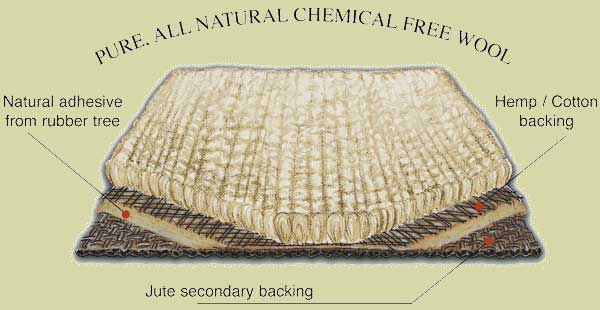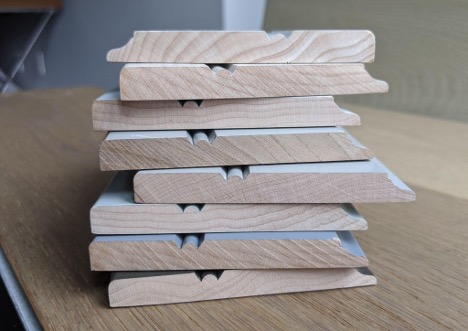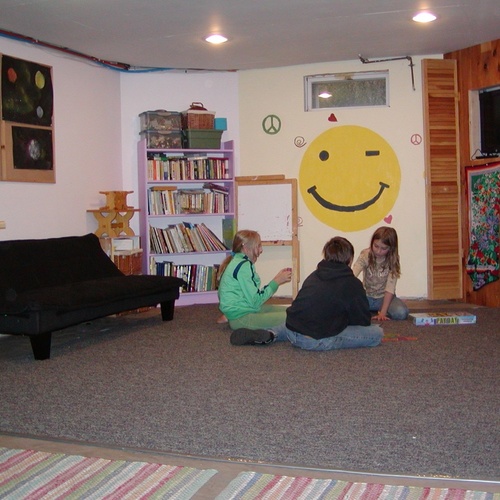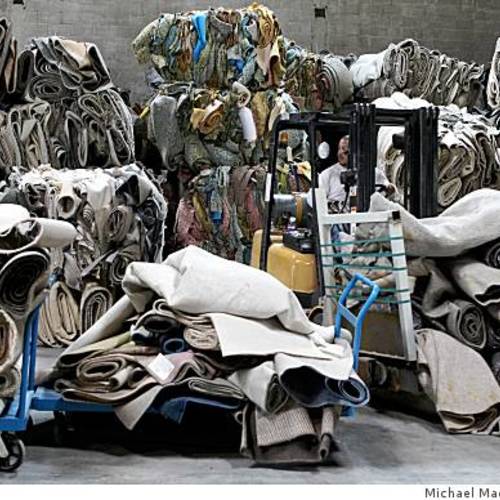
If you are considering wall-to-wall carpet for your home or project—stop, look, and read on. Take a minute to think about the pros and cons of your carpet choices before you buy that next roomful.
Carpet is synonymous with comfort—it’s soft, absorbs sound, and makes a house warmer, literally and figuratively. Unfortunately, it also contributes to poor indoor air quality (IAQ)—off-gassing volatile organic compounds (VOCs), absorbing and retaining moisture that can lead to mold, and is a huge sinkhole for dirt and dust mites.
Our first home had a lovely salt-and-pepper shag carpet (came with the old farmhouse!) that I decided to rip out early one Saturday morning. I was stunned by the amount of detritus that had worked its way down through the carpet and pad to the old wood floor. We removed buckets of debris from that house and eventually refinished the beautiful old wood floors. That experience and visual is still with me 25 years later (thank you for indulging my digression!).
If your heart and feet are set on carpet, go with natural fibers, like wool, hemp, silk, linen, and sisal. My favorite is wool: The innate beauty and durability of pure wool provides a natural soil barrier, adds warmth and comfort, is inherently flame resistant—plus, it comes from a renewable resource. Look for natural fiber carpets free of toxic dyes, pesticides, herbicides, and flame retardants. Two of my favorites are Earth Weave and Nature’s Carpet, both 100% wool complemented by solid environmental practices.
Carpet is two-faced. Check the content literally from front to back, as the carpet backing is equally important as its face. Look for backing made from natural latex, rubber, hemp, cotton, and jute, all of which can come from nontoxic, renewable sources.
If the products are made from natural raw materials and contain no added toxins, they can biodegrade responsibly at the end of their life.
Ensure healthful carpet installation by using tack strips instead of adhesives, which can be loaded with VOCs and make the carpeting harder to remove/replace/reuse/recycle later on. Padding increases softness and the carpet’s life, so, again, look for natural wool and rubber; there are many made from recycled products.
Clean your carpeting using a HEPA vacuum, and vacuum often. Within the first few months of installing natural-fiber carpet, it will release a healthy amount of fiber filaments–this is normal and will subside after three to six months, depending on daily traffic and wear patterns. Natural wool carpet rarely needs shampooing; spot “dry” cleaning with a nontoxic product protects the life of the lanolin inherent in the fiber, which is the natural stain barrier. If you choose to shampoo your carpet, use nontoxic, natural cleaners from well-known resources like AFM Safecoat and Earth Friendly Products.
Insist that family and guests remove their shoes the moment they walk in the door—I’m still working with my husband on that house rule! Ann’s article, “Favorite Things: The Shoe Bench,” also mentions how shoes track in pesticides and other noxious and toxic chemicals, which stick to and build up on our floors, especially on carpet.
Last but not least, ask for sustainable carpet certifications and standards:
- Green Label and Green Label Plus are second-party certifications from the Carpet & Rug Institute (CRI) for addressing indoor air quality. Carpet, padding, and adhesives that carry these labels emit minimal VOCs and formaldehyde and are typically free of flame retardants (polybrominated diphenyl, ether).
- Products that have undergone the NSF/ANSI 140-2007 Sustainable Carpet Assessment Standard were evaluated for their full life cycle—public health, energy efficiency, content, and manufacturing process— and meet recycling goals set forth by Carpet America Recovery Effort (CARE).
The carpet industry is the first to produce an ANSI-approved, multiattribute certification for environmentally preferable products.
I prefer the flexibility, cleanability, durability, and long life of my Saltillo tile floor, which is accented with beautiful area rugs in my main living and working areas. But I have to admit that the 100%-natural wool carpet in the bedrooms is an ideal blend of both worlds.
Weekly Newsletter
Get building science and energy efficiency advice, plus special offers, in your inbox.











6 Comments
Two other cleaning methods
For those who prefer traditional cleaning methods to regular use of a HEPA vacuum, here are the two ways I clean my carpets:
1. Put them on the clothesline and beat them vigorously with a carpet beater or an ordinary broom. Perform these actions for two to three times as long as you think is necessary, or until dust stops falling.
2. On a cold winter day, spread the carpet on clean snow and tread on the carpet with your boots. Flip the carpet over and repeat. Dry snow is excellent for cleaning carpets.
An Often Over Looked Flooring Issue
Excellent advice on carpeting. I too, opt for tile however that still needs to be "Warmed Up" with area rugs in most cases.
Very surprised we don't see more written on Moisture problems with slab on grade flooring. In most cases it is left up to a flooring subcontractor to worry about Moisture Vapor Emmisions. Sure, they want a good install and not have to worry about warranty or call back issues but they also want to be competitive with their pricing and in most cases will not recommend the extra cost associated with treating a concrete slab to waterproof it.
We install Vapor barriers under a slab and look for a concrete that has a low porosity and good strength, but we are still inviting problems by not waterproofing the concrete slab. Vapor Barriers are subject being compromised by all types of penetrations as well as mechanics accidentally punching a hole in it and saying "what the heck we have concrete going over it". What about the slab edges exposed to the atmosphere on the sides? Excellent path for moisture to enter the matrix, even with a moisture barrier!
Let's say we have an install contractor or architect that goes the extra mile and calls for ASTM 2170 Testing before a floor install! Great news, less than 70% humidity on the slab interior, were good to install! Months later we see moisture problems and start scratching our heads and the blame game starts!
Could it be that the high effieciency, variable speed HVAC system with the Merv 9 filtration is causing the problem? You had better beleve it. Were doing such a good job of removing the humidity inside the home and we are so careful to size our HVAC we are pulling moisture out of the slab making it come to the less humid environment inside via the gel-pore/capillary system in all concrete structures.
That 70% R/H reading we saw with the 2170 test goes right out the window when moisture starts migrating through a slab seeking that nice cool low humidity interior. Throw in a high humidity climate, lot of rain and high ground water tables and here comes the moisture. It will destroy bonds condense and saturate padding and carpet and our Indoor Environmental Quality went out the same window with the testing that we did!
Ever walk down the hallway in a Hospital and seen bubbles sticking up 3/8" above the floor grade? Ever seen maintenance people using razor knifes to cut them open just to soak up water that had accumulated under their terribly expensive seamless rubber flooring system? Kind of hard to sanitize an operating room floor held together with duct tape after you cut it open to soak water! Besides, "it doesn't look nice".
Yeah it'll cost about $1,000.00 to waterproof a 2,000 sq.ft. concrete slab. What will it cost to replace the flooring later? What is the moisture going to do for the Indoor Environmental Quality, when it gets in. Pretty simple matter to look in CSI Section 03-05-00 for a Concrete Waterproofing Compound and avoid problems.
By the way, you can use the same stuff to permanently seal the grout joints on your tile floor, providing the tile guy uses a Portland Cement based grout. Keeps anything from penetrating into a grout and staining it.
Off my Soap Box for now! Glenn
Area Rug Cleaning & Slab On Grade Flooring
Hi Glenn,
I love your soap box! Excellent information and strategies for slab on grade flooring...thank you!
Hi Martin,
I'm loving summer, not longing for snow but that said, I look forward to trying your 'dry cleaning' method for my area rugs.
Thanks much gentleman!
So I wool carpet would be my
So I wool carpet would be my best shot... I am actually interested in a carpet that can get cleaned fast with no additional effort, I have my share of bad experiences with carpets, even now with my relatively new carpet I have appointments at the carpet cleaner's once in two months besides the daily regular vacuum cleaning.
Wool Carpet
I've had a positive experience with our 100% natural, un-dyed wool carpet. It was installed over 16 years ago and still looks great. Numerous cat and dog mishaps over the years, we let them dry and they typically vacuum right up. If any stain or residue remains I use 7th Generations Carpet and Spot Stain Remover or a baking soda, both work well.
I have to admit that we usually only vacuum 2-3x a month - the carpet is on our stairs and bedrooms which sees no shoe traffic so stays fairly debris free.
Hope this helps, let me know if you have any other questions. Good luck!
Wool Worsted Rugs
Is it fair to say all the same things about wool worsted RUGS? I have several in my GREEN home and they look brand new after 2 years of heavy traffic, drink spills, fur balls, cat vomit, and a fair amount of aerobic activity. (I don't have a gym membership).
I was told I would have to send these out to be professionally cleaned. I don't really want to deal with that and I'm not convinced it is particularly necessary. Would love hear what others have to say. We used Karastan -- a locally made product -- and I absolutely love them.
Log in or create an account to post a comment.
Sign up Log in